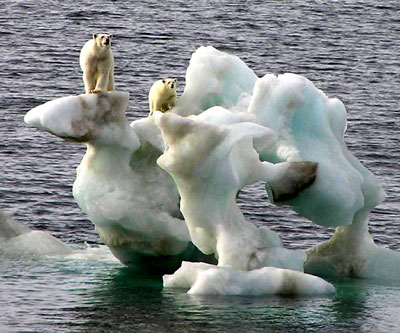How are Arctic sea-ice, climate and culture all connected?
Explain:
The Cryosphere was described by the “National Snow and Ice Data Center” as the places on the earth that scientists describe as regions that are cold enough that water freezes to solid ice or snow. I describe the Cryosphere as the parts of the World that have water in a solid phase such as snow, lake ice, sea ice or glaciers. The Cryosphere has a different significance for each region that it supports, but on a global scale it is essentially our cooling system (or air conditioning if you will). The Cryosphere, or solid water of the world, provides our planet with the ability to maintain the cool temperatures that allow all living things to thrive. It keeps our ocean temperatures consistent and keeps our atmosphere from overheating.
Depending on the whether it is snow or ice, water phase will determine the amount of heat that is absorbed or reflected from the surface of the earth. The absorption of heat is what melts the ice or water of our earth. The reflection, or albedo, is what keeps the temperature of the atmosphere stable. The interactive video, Earth’s Albedo and Global Warming is a perfect example of the effects that the absorption and reflection heat from the earth’s sun can have on the Cryosphere. As we see in the video, liquid water absorbs the most heat from the sun - resulting in increases of sea or lake water temperatures around the globe.
By using on-line research programs such as The Cryosphere Today, we can see the direct effects of the absorption of heat currently taking place in different regions of the world. We can also compare the total area of ice in these regions from earlier dates. We are seeing drastic declines of sea ice in the Arctic. The Arctic sea ice is very important because it is the world’s sensor to the effects of climate change. However, being the world’s sensor is not it’s only function; culturally, Arctic Sea ice provides subsistence hunting grounds and means of travel for many indigenous peoples. The ice allows the indigenous peoples a way to connect the younger generations to their cultural ways of life. The sea ice also provides an ecosytem to many animals including polar bears, whales, walruses and sea lions among many others.
Extend:
The study of the Cryosphere is something that I was formally introduced to after a training that I attended at Chena Hot Springs last winter. I had informally been studying the Cryosphere while learning about snow hydrology and avalanche safety through University of Alaska Southeast as an undergraduate. I remember being intrigued by the concept of the idea of something called Snow Water Equivalent - or SWE - and how this simple measurement could help us determine the water availability in a particular area. I now have a true appreciation for this knowledge and recognize how this can help researchers determine temperature increase due to ice and snow melt. I also remember how excited I was last year while developing lessons in coordination with the inquiry based science I had been doing all week at the training at Chena Hot Springs and my excitement has been revitalized with the idea of incorporating the Cryosphere into my curriculum.
Polar Bear Picture
Subscribe to:
Post Comments (Atom)



What a COOL blog! I like how you blend the course resources with your experiences and interests as a teacher.
ReplyDeleteAnd...that polar bear picture!!!!!